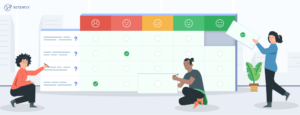Lifecycle emails play a key role in building, nurturing and strengthening the relationship between your business and your customers.
Done right, they can help you develop a closer connection between your customers and your product, increasing your customer lifetime value (CLV).
The reason these types of emails are called “lifecycle emails” instead of simply “emails” is that they’re designed and crafted to achieve a specific objective at a particular point in the customer’s lifecycle.
A welcome email aims to greet and onboard a new customer, thus reducing short-term product abandonment due to confusion or mistaken signups. Similarly, an email sent after a trial user becomes a paying customer shows you’re there for them and value their business, reinforcing the relationship between your company and its customers.
Net Promoter Score® is designed specifically to collect actionable feedback from your audience, and as such, it’s a great tool to implement into your customer lifecycle emails.
Below, we’ve shared several techniques you can use to fit NPS surveys into your customer emails in order to gain comprehensive insights into everything, from your onboarding process to the product’s feature set, usability and overall value.
Benefits of Incorporating NPS Surveys into Lifecycle Emails
Incorporating NPS surveys into your customer lifecycle emails can provide a wealth of data. Let’s dive into some of the key benefits:
1. Actionable Insights at Each Lifecycle Event
NPS surveys are like listening posts scattered across your customers’ journeys, collecting real-time insights at crucial stages. For instance, when new customers respond to an onboarding survey, you’ll know if they’re smoothly transitioning or hitting bumps along the way. Post-purchase surveys reveal whether the product lives up to expectations or if there are lingering issues that need attention. By strategically placing NPS surveys, you’ll see exactly where customers are thrilled or frustrated, helping you prioritize improvements and act promptly.
2. Refining Email Marketing Strategies
The data collected through NPS surveys becomes your secret sauce for refining email marketing. By analyzing the survey responses, you can segment customers into Promoters, Passives, and Detractors, each with unique needs. This allows you to tailor email content specifically for each group:
- Promoters: Engage them with loyalty rewards, exclusive content, or referral incentives.
- Passives: Nurture them with targeted emails addressing their specific needs or concerns.
- Detractors: Send personalized emails to understand their pain points better and offer solutions to win them back.
This kind of segmentation sharpens your email strategy, ensuring that every message resonates and converts more effectively.
3. Impact on Customer Retention and Advocacy
Happy customers are loyal customers. By integrating NPS surveys, you’re building a feedback loop that fosters customer-centric improvements. When customers see their input is valued and leads to real changes, they are more likely to stick around. Promoters become brand advocates, spreading positive word-of-mouth that attracts new customers. Even addressing Detractors’ concerns swiftly can often turn them into satisfied clients. This cumulative effect leads to higher retention rates, lower churn, and a brand community that’s engaged and enthusiastic.
Incorporating NPS surveys into customer lifecycle emails is about listening, learning, and acting on feedback to create a customer experience that nurtures loyalty and advocacy. The insights help you pivot quickly, refine your strategies, and build a business that customers love to recommend.
Include NPS Surveys After Key Customer Lifecycle Events
There are several key events in a customer’s journey, each of which has a different significance for your business.
Some analysts refer to these as “phases” of the customer lifecycle — an entirely accurate description. However, from a marketer’s perspective oriented on results and feedback, it can be easier to focus on more specific events than particular phases. Let’s dive in for more details:
1. Discovery
The first event in the customer lifecycle is discovery. This is when a customer identifies a need and seeks out a solution. This might be how a customer discovers your product through organic or paid search, advertising or a recommendation from someone else. At this point, it’s all about creating a positive first impression and conveying your value proposition effectively so that your brand stands out in their minds.
NPS surveys can be a surprising yet effective tool here. While NPS is traditionally used to measure satisfaction post-purchase, it can also provide insights into how your brand is perceived during these early touchpoints. You can use NPS surveys to measure initial impressions and brand appeal by reaching out to those who engage with your brand early on, such as after they’ve signed up for your email newsletter or downloaded a piece of content.
Ask them how likely they are to recommend your brand based on what they’ve seen so far and include follow-up questions that reveal what stood out to them and what left them uncertain. This data can help you understand how your initial messaging resonates with potential customers and identify gaps in your content that may leave them undecided. By fine-tuning your early touchpoints based on this NPS data, you can create a stronger first impression and ensure that your brand is seen as a credible and valuable choice right from the start.
While you can survey non-customer website users at this point, it’s best to keep their feedback separate from paying customers.
2. Evaluation
The second event in the customer lifecycle is evaluation. At this point, a customer has found your website and bumped into your product. They’ve decided that it might be the product they need, but they’re not yet informed enough to make a buying decision.
It’s the moment when prospects are actively evaluating your offerings and comparing them with competitors. They’re weighing various options, seeking out reviews, and trying to determine which product or service best meets their needs. Here, your job is to convince them why your brand stands out.
With a SaaS product, the event that defines the “evaluation” phase is usually a user signing up for your free trial and starting to use your product over the course of one week, two weeks or a month.
This is the first key event in the customer lifecycle in which NPS starts to become beneficial for learning more about your customers.
Integrating NPS surveys into lifecycle emails at this point can offer valuable insights for understanding what influences customer purchase decisions and shaping your messaging to address their concerns. Here’s how NPS can help:
- Revealing Perceptions of Your Brand
During the evaluation phase, prospects often hold strong impressions that determine whether they’ll proceed to purchase or not.
An NPS survey can reveal these perceptions and help you understand their current level of trust in your brand. Do they see it as trustworthy and reliable? Are there elements that are unclear or off-putting?
For instance, low scores might indicate uncertainty or misconceptions that you can address through better content or more detailed product information.
These insights allow you to refine your value proposition, messaging, and customer experience to make your brand the clear choice.
- Influencing Purchase Decisions
The open-ended feedback from NPS surveys can uncover what potential customers are most concerned about before making a purchase decision.
If prospects cite price, functionality, or customer support as decisive factors, you can address these concerns directly in your follow-up emails or content, ensuring your brand positions itself favorably.
- Addressing Competitor Comparisons
Prospects often compare your brand with competitors, and their input can offer clues on where you’re lacking or excelling. If they mention certain features or services that your competitors offer but you don’t, it might be an opportunity to improve or differentiate your offerings.
This comparative insight can guide your competitive positioning, helping you refine your value proposition to better align with what potential customers are looking for.
Therefore, by gathering and analyzing NPS data, you can gain a deep understanding of prospects’ needs and their perception of your brand, ultimately crafting a tailored strategy that gently nudges them toward purchase.
Nota bene:
If a free trial user converts into a paying customer after your free trial email sequence, you can use an NPS survey to find out more about how likely they are to renew their subscription (assuming your product or service uses a monthly pricing model).
If a free trial user doesn’t convert into a paying customer, you can also send an NPS survey to learn why your product or service failed. These surveys can often provide the most actionable and valuable feedback for improving your product.
3. Purchase
It’s when a prospect finally makes the decision to buy your product or service. This critical step is often the culmination of research, comparisons, and evaluations, leading them to place their trust in your brand. Here, the focus shifts to delivering a smooth and satisfying buying experience that affirms their choice.
Since new customers are often the most enthusiastic ones about your product, sending a survey after a purchase is often the best way to get actionable feedback on the key factors that determined them to become paying customers.
In fact, this event can be a great trigger for starting your NPS process with a new customer. We usually recommend waiting 7-30 days after the conversion to start surveying customers, as this allows you to connect with them when the purchase event is still fresh in their memory.
NPS surveys in lifecycle emails can provide a valuable understanding of immediate customer sentiments about their purchase. This information is key for improving the purchase process and ensuring that customers start their adventure with your brand on the right foot. Here’s how:
- Understanding the Buying Experience
NPS survey gives you direct insight into how smooth and satisfying the buying process was for customers – insights that can be used to streamline and enhance future transactions.
This feedback can highlight strengths in the purchase journey, such as an intuitive checkout process, helpful sales staff, or quick delivery. It can also reveal friction points during checkout, such as unclear payment methods, difficult navigation, a confusing return policy or unexpected shipping costs. Therefore, data on customer preferences, pain points, and expectations can inform adjustments to pricing strategies, checkout flows, and customer support processes.
- Identifying Immediate Sentiments and Expectations
An NPS survey can also reveal customers’ initial feelings about the product or service they just bought. Did it meet their expectations?
If the survey indicates that new customers are excited, it’s a positive sign to reinforce your onboarding strategies. If the feedback indicates hesitation or uncertainty, there’s an opportunity to provide educational content, tutorials, or additional support to address their concerns and avoid returns.
4. Product Experience (Relationship Building)
Other key events in the customer lifecycle include product engagement — the experience of actually using your product. If you sell a SaaS product aimed at businesses, your customers might use your product every day, meaning this isn’t a one-off event, but an ongoing process.
Email marketing experts refer to this phase of the customer lifecycle as a “relationship-building” stage. This is normally when you start sending post-purchase follow-up emails, newsletters and other informational content aimed at building a relationship with your customers.
At this stage, your primary goal is to keep existing customers satisfied and engaged, ensuring they continue to use your products and remain loyal to your brand. It’s often much more cost-effective to retain customers than to acquire new ones, so focusing on customer satisfaction is key for sustainable growth.
From an NPS perspective, the optimal way to survey your customers in the relationship building is by being consistent and non-annoying. Don’t send an NPS survey email with every newsletter or post-purchase follow-up — instead, every 60 to 90 days is a good general practice.
This way, you’ll be able to track sentiment and satisfaction as customers go from being freshly acquainted with your product to using it more consistently. Are scores improving, declining, or holding steady? You’ll also be able to identify and act on negative feedback from Detractors by offering solutions and limiting churn.
Regular NPS surveys at this stage help you stay proactive rather than reactive, making it easier to identify emerging issues and resolve them before they become liabilities. Whether it’s product enhancements, better communication, or feature updates, customer suggestions provide a blueprint for refining your offering. By understanding what drives satisfaction and loyalty for different customer segments, you’ll be well-equipped to keep customers coming back for the long haul.
5. Advocacy
The final stage in the customer lifecycle is advocacy. At this point, email marketing transforms from being focused on onboarding customers and developing a relationship to providing a new opportunity for existing customers to help you grow your business.
During this stage of the customer lifecycle, conventional emails and NPS survey emails become more closely linked. After all, NPS is built around a question that’s the key goal of any advocacy email: recommending your product or service to other people.
As such, you can integrate NPS surveys into your advocacy emails very easily. NPS surveys categorize customers based on their likelihood of recommending your brand, making it easy to identify Promoters (scores of 9 or 10). For example, try segmenting your Promoters into a separate email list and creating an advocacy campaign that’s specifically targeted toward the people most likely to recommend your product or service.
Or, use our other Promoter-focused tactics in your advocacy emails to leverage your high NPS for social media coverage, affiliate partnerships, case studies and other assets that help your business grow.
Remember, it’s still important to survey your customers even as they enter into the advocacy phase of the customer lifecycle. A survey (either incorporated into an existing email or sent on its own) every 90 days will help you generate insight while maintaining an accurate score.
Other Tactics for Fitting NPS Into Your Email Marketing
Used effectively, Net Promoter Score surveys can both enhance and complement your existing email marketing. In addition to the techniques we’ve listed above, you can also use the following tactics to fit NPS into your customer lifecycle email content:
- Send one-off NPS survey emails after major product announcements, updates and new features to quickly and accurately gauge customer sentiment.
- Use NPS surveys to learn more when customers respond directly to your lifecycle emails with their thoughts, opinions and ideas.
- Send NPS surveys if and when customers become inactive to find out more about what’s holding them back from using your product.
- Use exit NPS surveys when a customer decides to stop using a product or service to understand their experience, capture the reasons for leaving and drive further improvements.
Because NPS is built around such a simple survey, it’s an incredibly flexible system that you can use in a wide variety of situations. From onboarding emails to announcements, NPS has a place in almost every part of the customer lifecycle email process.
Yet, to get the most out of your NPS surveys, follow these best practices to ensure you’re reaching the right people at the right time with surveys that are clear and engaging:
1. Segmentation
Start by segmenting your audience based on their lifecycle stage. Customers at different points in their journey will have different priorities and expectations. For instance, brand-new customers might focus on ease of use or clarity, while long-time clients will be concerned about consistent quality and new features. Segmenting helps you ask more relevant questions and interpret inputs in the proper context. Plus, it enables you to target your follow-up actions more effectively.
2. Timing
Timing is everything. Send NPS surveys when customers are most likely to engage. For trial users, consider sending a survey a few days after the customer starts using your product to get fresh feedback. For post-purchase surveys, wait until customers have had enough time to experience the product but not so long that their excitement fades. Regular surveys during the relationship-building phase can help identify shifting customer needs, while churn-risk customers can be asked for their input before they slip away. By sending surveys strategically, you ensure higher response rates and more accurate data.
3. Personalization
Make your NPS emails feel personal to each recipient. Use their name, reference their recent purchases, or acknowledge specific interactions they’ve had with your brand. This isn’t just about being friendly; it shows that you value them as individuals. When customers feel recognized and understood, they’re more likely to provide thoughtful and honest feedback. For instance, an email that says, “Hey [Name], you’ve been with us for six months now, and we’d love to hear how we’re doing!” will resonate far more than a generic message.
4. Mobile-Friendly
Many customers open emails on mobile devices, so your NPS surveys should be optimized accordingly. Make sure your emails are easy to read and that the survey itself is quick and straightforward to complete on a smartphone. Keep the layout clean, the text concise, and the rating scale prominent. The simpler the survey, the better your response rate will be. Also, consider adding a progress bar if your survey has multiple questions, giving respondents an idea of how close they are to finishing.
By following these best practices, you’ll be able to seamlessly integrate NPS surveys into your customer lifecycle emails, maximizing engagement, and gathering high-quality input that you can act upon.
Send NPS Surveys and Calculate Your Score With Retently
Integrating NPS surveys into your customer lifecycle emails is a powerful strategy that provides unparalleled insights into customer sentiment throughout their journey. By strategically timing these surveys and tailoring follow-up actions, you can build stronger relationships with Promoters, uncover opportunities to convert Passives into advocates, and address the concerns of Detractors. This approach improves customer satisfaction and loyalty while refining your email marketing strategy to deliver content that resonates deeply.
By analyzing feedback and segmenting customers based on NPS scores, you gain actionable data to inform future campaigns, creating a loop that continuously enhances customer communication. A/B testing and regular iteration further optimize the integration process, ensuring that your email campaigns are always improving.
Retently makes it easy to send Net Promoter Score surveys to your customers, letting you read, analyze and act on customer feedback to increase retention and build a larger, more profitable business.
Get started by creating your free Retently account – no long-term obligation, contract or credit card is required. Incorporate NPS surveys in your customer lifecycle emails today, and watch your customer relationships – and business – flourish.

















 Alex Bitca
Alex Bitca 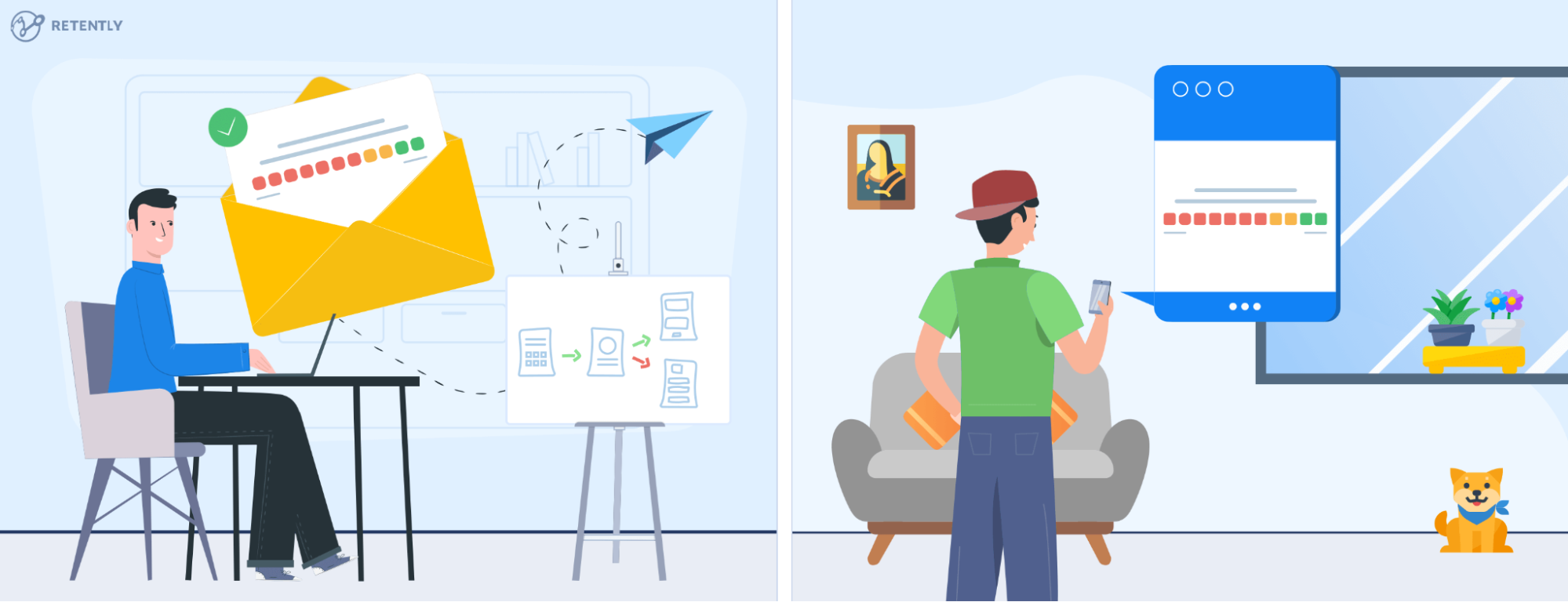
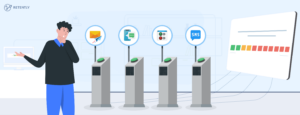

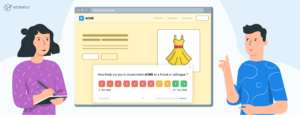
 Christina Sol
Christina Sol 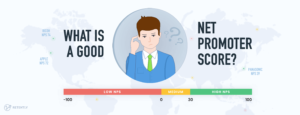
 Greg Raileanu
Greg Raileanu 

